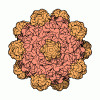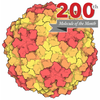[English] 日本語
 Yorodumi
Yorodumi- PDB-7rk9: Cryo-EM Structure of Adeno-Associated Virus Serotype 1 with Engin... -
+ Open data
Open data
- Basic information
Basic information
| Entry | Database: PDB / ID: 7rk9 | |||||||||
|---|---|---|---|---|---|---|---|---|---|---|
| Title | Cryo-EM Structure of Adeno-Associated Virus Serotype 1 with Engineered Peptide Domain PHP.B (AAV1-PHP.B) | |||||||||
 Components Components | Capsid protein | |||||||||
 Keywords Keywords | VIRUS / Gene Therapy / Adeno-associated virus / AAV | |||||||||
| Function / homology | Phospholipase A2-like domain / Phospholipase A2-like domain / Parvovirus coat protein VP2 / Parvovirus coat protein VP1/VP2 / Parvovirus coat protein VP2 / Capsid/spike protein, ssDNA virus / T=1 icosahedral viral capsid / structural molecule activity / Capsid protein Function and homology information Function and homology information | |||||||||
| Biological species |  Adeno-associated virus - 1 Adeno-associated virus - 1 | |||||||||
| Method | ELECTRON MICROSCOPY / single particle reconstruction / cryo EM / Resolution: 2.32 Å | |||||||||
 Authors Authors | Fluck, E.C. / Pumroy, R.A. / Moiseenkova-Bell, V.Y. | |||||||||
| Funding support |  United States, 2items United States, 2items
| |||||||||
 Citation Citation |  Journal: J Virol / Year: 2021 Journal: J Virol / Year: 2021Title: Context-Specific Function of the Engineered Peptide Domain of PHP.B. Authors: R Alexander Martino / Edwin C Fluck / Jacqueline Murphy / Qiang Wang / Henry Hoff / Ruth A Pumroy / Claudia Y Lee / Joshua J Sims / Soumitra Roy / Vera Y Moiseenkova-Bell / James M Wilson /  Abstract: One approach to improve the utility of adeno-associated virus (AAV)-based gene therapy is to engineer the AAV capsid to (i) overcome poor transport through tissue barriers and (ii) redirect the ...One approach to improve the utility of adeno-associated virus (AAV)-based gene therapy is to engineer the AAV capsid to (i) overcome poor transport through tissue barriers and (ii) redirect the broadly tropic AAV to disease-relevant cell types. Peptide- or protein-domain insertions into AAV surface loops can achieve both engineering goals by introducing a new interaction surface on the AAV capsid. However, we understand little about the impact of insertions on capsid structure and the extent to which engineered inserts depend on a specific capsid context to function. Here, we examine insert-capsid interactions for the engineered variant AAV9-PHP.B. The 7-amino-acid peptide insert in AAV9-PHP.B facilitates transport across the murine blood-brain barrier via binding to the receptor Ly6a. When transferred to AAV1, the engineered peptide does not bind Ly6a. Comparative structural analysis of AAV1-PHP.B and AAV9-PHP.B revealed that the inserted 7-amino-acid loop is highly flexible and has remarkably little impact on the surrounding capsid conformation. Our work demonstrates that Ly6a binding requires interactions with both the PHP.B peptide and specific residues from the AAV9 HVR VIII region. An AAV1-based vector that incorporates a larger region of AAV9-PHP.B-including the 7-amino-acid loop and adjacent HVR VIII amino acids-can bind to Ly6a and localize to brain tissue. However, unlike AAV9-PHP.B, this AAV1-based vector does not penetrate the blood-brain barrier. Here we discuss the implications for AAV capsid engineering and the transfer of engineered activities between serotypes. Targeting AAV vectors to specific cellular receptors is a promising strategy for enhancing expression in target cells or tissues while reducing off-target transgene expression. The AAV9-PHP.B/Ly6a interaction provides a model system with a robust biological readout that can be interrogated to better understand the biology of AAV vectors' interactions with target receptors. In this work, we analyzed the sequence and structural features required to successfully transfer the Ly6a receptor-binding epitope from AAV9-PHP.B to another capsid of clinical interest, AAV1. We found that AAV1- and AAV9-based vectors targeted to the same receptor exhibited different brain-transduction profiles. Our work suggests that, in addition to attachment-receptor binding, the capsid context in which this binding occurs is important for a vector's performance. | |||||||||
| History |
|
- Structure visualization
Structure visualization
| Movie |
 Movie viewer Movie viewer |
|---|---|
| Structure viewer | Molecule:  Molmil Molmil Jmol/JSmol Jmol/JSmol |
- Downloads & links
Downloads & links
- Download
Download
| PDBx/mmCIF format |  7rk9.cif.gz 7rk9.cif.gz | 5.3 MB | Display |  PDBx/mmCIF format PDBx/mmCIF format |
|---|---|---|---|---|
| PDB format |  pdb7rk9.ent.gz pdb7rk9.ent.gz | Display |  PDB format PDB format | |
| PDBx/mmJSON format |  7rk9.json.gz 7rk9.json.gz | Tree view |  PDBx/mmJSON format PDBx/mmJSON format | |
| Others |  Other downloads Other downloads |
-Validation report
| Summary document |  7rk9_validation.pdf.gz 7rk9_validation.pdf.gz | 1.7 MB | Display |  wwPDB validaton report wwPDB validaton report |
|---|---|---|---|---|
| Full document |  7rk9_full_validation.pdf.gz 7rk9_full_validation.pdf.gz | 2 MB | Display | |
| Data in XML |  7rk9_validation.xml.gz 7rk9_validation.xml.gz | 728.6 KB | Display | |
| Data in CIF |  7rk9_validation.cif.gz 7rk9_validation.cif.gz | 1.1 MB | Display | |
| Arichive directory |  https://data.pdbj.org/pub/pdb/validation_reports/rk/7rk9 https://data.pdbj.org/pub/pdb/validation_reports/rk/7rk9 ftp://data.pdbj.org/pub/pdb/validation_reports/rk/7rk9 ftp://data.pdbj.org/pub/pdb/validation_reports/rk/7rk9 | HTTPS FTP |
-Related structure data
| Related structure data |  24495MC  7rk8C M: map data used to model this data C: citing same article ( |
|---|---|
| Similar structure data |
- Links
Links
- Assembly
Assembly
| Deposited unit | 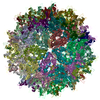
| ||||||||||||||||||||||||||||||||||||||||||||||||||||||||
|---|---|---|---|---|---|---|---|---|---|---|---|---|---|---|---|---|---|---|---|---|---|---|---|---|---|---|---|---|---|---|---|---|---|---|---|---|---|---|---|---|---|---|---|---|---|---|---|---|---|---|---|---|---|---|---|---|---|
| 1 |
| ||||||||||||||||||||||||||||||||||||||||||||||||||||||||
| Noncrystallographic symmetry (NCS) | NCS domain:
|
 Movie
Movie Controller
Controller


 UCSF Chimera
UCSF Chimera
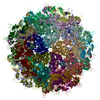
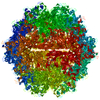
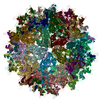
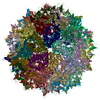
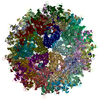
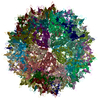
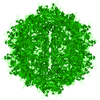
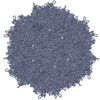
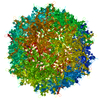
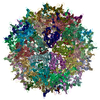
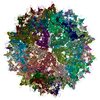
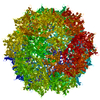

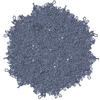
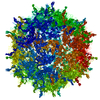
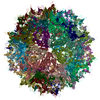
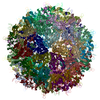
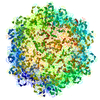
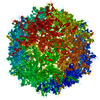

 PDBj
PDBj
